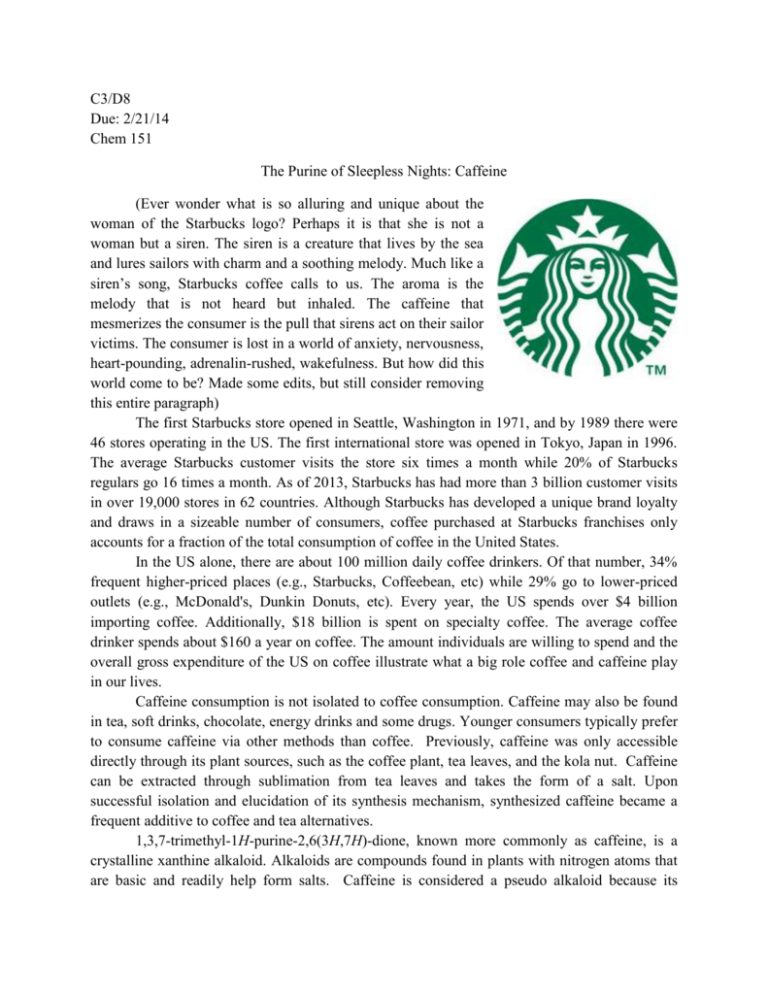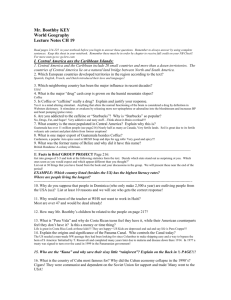Document
advertisement

C3/D8 Due: 2/21/14 Chem 151 The Purine of Sleepless Nights: Caffeine (Ever wonder what is so alluring and unique about the woman of the Starbucks logo? Perhaps it is that she is not a woman but a siren. The siren is a creature that lives by the sea and lures sailors with charm and a soothing melody. Much like a siren’s song, Starbucks coffee calls to us. The aroma is the melody that is not heard but inhaled. The caffeine that mesmerizes the consumer is the pull that sirens act on their sailor victims. The consumer is lost in a world of anxiety, nervousness, heart-pounding, adrenalin-rushed, wakefulness. But how did this world come to be? Made some edits, but still consider removing this entire paragraph) The first Starbucks store opened in Seattle, Washington in 1971, and by 1989 there were 46 stores operating in the US. The first international store was opened in Tokyo, Japan in 1996. The average Starbucks customer visits the store six times a month while 20% of Starbucks regulars go 16 times a month. As of 2013, Starbucks has had more than 3 billion customer visits in over 19,000 stores in 62 countries. Although Starbucks has developed a unique brand loyalty and draws in a sizeable number of consumers, coffee purchased at Starbucks franchises only accounts for a fraction of the total consumption of coffee in the United States. In the US alone, there are about 100 million daily coffee drinkers. Of that number, 34% frequent higher-priced places (e.g., Starbucks, Coffeebean, etc) while 29% go to lower-priced outlets (e.g., McDonald's, Dunkin Donuts, etc). Every year, the US spends over $4 billion importing coffee. Additionally, $18 billion is spent on specialty coffee. The average coffee drinker spends about $160 a year on coffee. The amount individuals are willing to spend and the overall gross expenditure of the US on coffee illustrate what a big role coffee and caffeine play in our lives. Caffeine consumption is not isolated to coffee consumption. Caffeine may also be found in tea, soft drinks, chocolate, energy drinks and some drugs. Younger consumers typically prefer to consume caffeine via other methods than coffee. Previously, caffeine was only accessible directly through its plant sources, such as the coffee plant, tea leaves, and the kola nut. Caffeine can be extracted through sublimation from tea leaves and takes the form of a salt. Upon successful isolation and elucidation of its synthesis mechanism, synthesized caffeine became a frequent additive to coffee and tea alternatives. 1,3,7-trimethyl-1H-purine-2,6(3H,7H)-dione, known more commonly as caffeine, is a crystalline xanthine alkaloid. Alkaloids are compounds found in plants with nitrogen atoms that are basic and readily help form salts. Caffeine is considered a pseudo alkaloid because its structure contains a heterocyclic ring with nitrogen embedded and the compound is not a derivative of an amino acid [1]. The structure of caffeine bears some resemblance to adenosine, a purine nucleoside. Adenosine has a similar structure to caffeine but its role in the body is entirely different. This neurotransmitter is a sugar that binds to its associated receptors around the body. When adenosine triphosphate (ATP) is broken down in neurons for energy usage during wakeful hours, adenosine concentrations increase. The adenosine in the neurons is transported into the Figure 1. Structures of extracellular space where “A1 (adenosine) receptors of the basal Caffeine and Adenosine [4] nucleus neurons are particularly sensitive to the increased levels F of adenosine” [7]. Due to their sensitivity, potassium ion concentrations increase inside the neuron, leading to its inhibition. GABA neuron activity also decreases, which in turn disinhibit neurons responsible for Slow-Wave Sleep (SWS) [7]. GABA, known as gamma-aminobutyric acid, decreases a neuron’s action potential, which at a certain level will not allow a neuron to generate action potentials [8]. When a neuron stops generating action potentials, other neurons nearby will not be excited. Thus, wakefulness decreases as a result when SWS neurons are disinhibited. Caffeine plays an opposite role causing neuron action potentials to increase, exciting other neurons, and adding to the state of wakefulness. Caffeine is a stimulant and interacts with the central nervous system by binding to adenosine receptors in the brain and around the body, preventing adenosine from binding and inducing its associated effects. Such effects include drowsiness, dilation of blood vessels, lowering of blood pressure and body temperature, lowering rate of digestion, and the easing of stress [2]. The binding of caffeine causes neurons to fire more rapidly, causing a chain reaction involving the pituitary gland, which releases hormones that bind to adrenal glands that subsequently release “adrenaline (epinephrine)”, the “fight-or-flight” hormone [3]. Actions that arise from this cascade include increased blood flow and pressure, increased glycogen breakdown for the release of glucose into the bloodstream, and the increased contraction of muscle cells. Before the effects of caffeine are realized, the liver must first metabolize the compound. Three main products result from the breakdown leading to their own respective effects (Fig. 2). Paraxanthine increases the rate of lipid breakdown in the liver, leading to increased fatty acid concentrations in the blood stream. Theophyline, produced in a miniscule amount, relaxes the smooth muscle in bronchi in the lungs. Theobromine dialates or widens the blood vessels, decreasing blood pressure. In addition, caffeine itself inhibits phosphodiesterase, an enzyme that catalyzes the degradation of cyclic AMP [4]. Protein kinases that depend on cAMP will not work properly as a result. For example, protein kinase A (PKA) is activated only in the presence of cAMP. These kinases (enzymes) specifically regulate “glycogen, sugars and lipid metabolism” [4]. In particular, activated PKA phosphorylates several kinds of proteins such as glycogen synthase, which aids in the packaging of glucose into glycogen when blood glucose levels are high. Caffeine inhibition of adenosine is not only tied to the three main products. When caffeine is metabolized, the following urinary metabolites are synthesized: 1-methyl xanthine, AFMU, and 1-methyluric acid (Fig. 2) [5]. These compounds are excreted in excess urine, which is a consequence of caffeine ingestion. All of the metabolites produced from caffeine are all purines and have some resemblance to adenosine. This explains the competitive inhibition of caffeine degradation products onto receptors such as the adenosine receptors: similar structures may bind to the same receptor and yield different reactions and bodily symptoms as mentioned. Caffeine structure is not the only factor that affects the response of the human body to the stimulant. The variations in certain genes and their respective DNA sequences account for the difference in the bodily response of individuals towards caffeine intake. CYP1A2 is the main cytochrome P450 enzyme that catalyzes reactions of caffeine metabolism. The Figure 2. Metabolic pathways for caffeine [5] differences in the DNA sequence of this enzyme affect how well or how fast caffeine is metabolized in the body of a consumer. Known as single nucleotide polymorphisms (SNPs), these DNA sequences differ in one nucleotide and can cause increases the amount of CYP1A2 enzymes in the liver, resulting in a faster and more efficient breakdown of caffeine [6]. SNPs in ADORA2A, a gene that codes for adenosine A2A receptors in the body, also affects the degree of caffeine symptom strength from caffeine intake. A study conducted by Emma Childs, a Research Figure 3. Caffeine metabolism showing enzyme catalysis by CYP1A2 [7] Associate (Assistant Professor) at Department of Psychiatry, University of Chicago, and a group of participants tested the strength of caffeine between two variables. One group did not have SNPs in their ADORA2A gene while another group had them. After consumption of 150 mg of caffeine, participants with the SNPs began feeling anxious. In contrast, the group without SNPs in the gene was able to consume up to 450 mg of caffeine, at which the individuals had to cope with increasing anxiety [6]. Thus, even miniscule changes in one nucleotide of a gene can significantly amplify caffeine- induced symptoms.






